Blog & Latest Updates
Fly Fishing Articles
Insects by Common Name


Mayfly Species Ephemera simulans (Brown Drake)
Taxonomic Navigation -?-
Kingdom
Animalia (Animals)
» Phylum
Arthropoda (Arthropods)
» Class
Insecta (Insects)
» Order
Ephemeroptera (Mayflies)
» Family
Ephemeridae (Hexes and Big Drakes)
» Genus
Ephemera
» Species simulans (Brown Drake)
Common Names
Where & When
Regions: East, Midwest, West
Time Of Year (?): Late May through early October; best in the Midwest in early June
Preferred Waters: Many trout streams, but also lakes
This hatch really shines in the Midwest, where it hatches from most large trout streams and many small ones. Angling books unanimously report that it lasts between three and five days in one location before moving upriver, but I know one large Midwestern spring creek where Ephemera simulans action lasts for a couple weeks in many stretches.Time Of Year (?): Late May through early October; best in the Midwest in early June
Preferred Waters: Many trout streams, but also lakes
It can also create good Eastern hatches in places like the lower Delaware drainage in the Catskills, where its blizzardlike hatches burn out after a few days. Eastern distribution is much spottier than in the Midwest.
This species is also widespread in the West, from Yellowstone to California to Alaska. It emerges later in the year than in the East, extending throughout June and into mid-July. Exceptionally high altitude and latitude can delay it into October.
Hatching Behavior
Time Of Day (?): Dusk
Habitat: All types of water, but better in runs and pools than in riffles
Water Temperature: Begins at 50°F
The nymphs are very fast emergers. I have seen them pop through the surface and into the air as if shot from a cannon. Fred Arbona confirms this observation in Mayflies, the Angler, and the Trout, stating that they leave the water's surface "almost instantly." Habitat: All types of water, but better in runs and pools than in riffles
Water Temperature: Begins at 50°F
This means the best technique for fishing the emergence is to imitate the nymphs. Violent rises may be indicative of trout chasing nymphs to the surface rather than taking duns. There are some accounts of fish feeding on the duns, but they are regarded as the least important stage of this species. Full-hackled imitations are common and successful, imitating the fluttering commotion of duns trying to quickly depart from the water.
Ted Fauceglia says in Mayflies that the best dun emergence occurs in mid to late afternoon. This conflicts with other authors, who write that afternoon emergence is uncommon phenomenon reserved for exceptionally cold, dark days.
Spinner Behavior
Time Of Day: Dusk and into darkness
The best fishing to come from Ephemera simulans is had during the spinner falls.The spinners appear at treetop height up to an hour or two before dark. Their clouds descend gradually, and on some nights they are so thick that they land all over the angler and anything else in the river. I had one of the large drakes fly straight into my eye--yet another reason to wear sunglasses while fishing.
Some nights the descending clouds of spinners frustratingly disappear back into the trees. Other times they blanket the water and every trout in the stream, including huge piscivorous (Piscivorous: Anything which eats primarily fish is a piscivore.) browns, may rise to them.
Nymph Biology
Current Speed: Slow to medium
Substrate: Sand and fine gravel, sometimes silt
Brown drake nymphs mature in one year in most places, but sometimes they take two. I have done very well fishing their imitations during non-hatch periods on a river where they are common.Substrate: Sand and fine gravel, sometimes silt
They prefer sand and fine gravel over the firm silt of their relatives in Hexagenia, but they are present in silty places too. My favorite place to collect them is a silty culvert pool in the headwaters of a small brook trout stream. Ephemera simulans cohabits there with Baetisca laurentina, Siphloplecton basale, and Eurylophella temporalis--a very uncommon bunch.
Ephemera simulans Fly Fishing Tips
Some anglers curse this hatch as an over-hyped disappointment. The promising clouds of spinners which vanish without falling spent (Spent: The wing position of many aquatic insects when they fall on the water after mating. The wings of both sides lay flat on the water. The word may be used to describe insects with their wings in that position, as well as the position itself.) certainly contribute to this frustration. It is more likely that anglers are seeing simultaneous emergences and spinner falls. The trout may eat their fill of nymphs below the surface and leave a blanket of spinners untouched, leaving the impression that they do not care for this species.
Pictures of 15 Mayfly Specimens in the Species Ephemera simulans:
Ephemera simulans (Brown Drake) Mayfly Nymph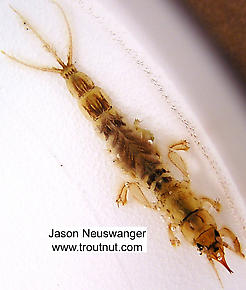 View 10 Pictures
View 10 Pictures
 View 10 Pictures
View 10 PicturesCollected January 31, 2004 from the Namekagon River in Wisconsin
Added to Troutnut.com by Troutnut on January 25, 2006
Added to Troutnut.com by Troutnut on January 25, 2006
Male Ephemera simulans (Brown Drake) Mayfly Spinner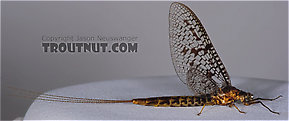 View 7 Pictures
View 7 Pictures
 View 7 Pictures
View 7 PicturesCollected June 2, 2005 from the Namekagon River in Wisconsin
Added to Troutnut.com by Troutnut on May 24, 2006
Added to Troutnut.com by Troutnut on May 24, 2006
Ephemera simulans (Brown Drake) Mayfly Nymph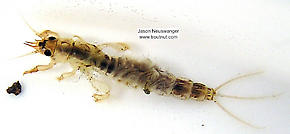 View 10 Pictures
View 10 Pictures
 View 10 Pictures
View 10 PicturesCollected January 31, 2004 from the Namekagon River in Wisconsin
Added to Troutnut.com by Troutnut on January 25, 2006
Added to Troutnut.com by Troutnut on January 25, 2006
2 Underwater Pictures of Ephemera simulans Mayflies:
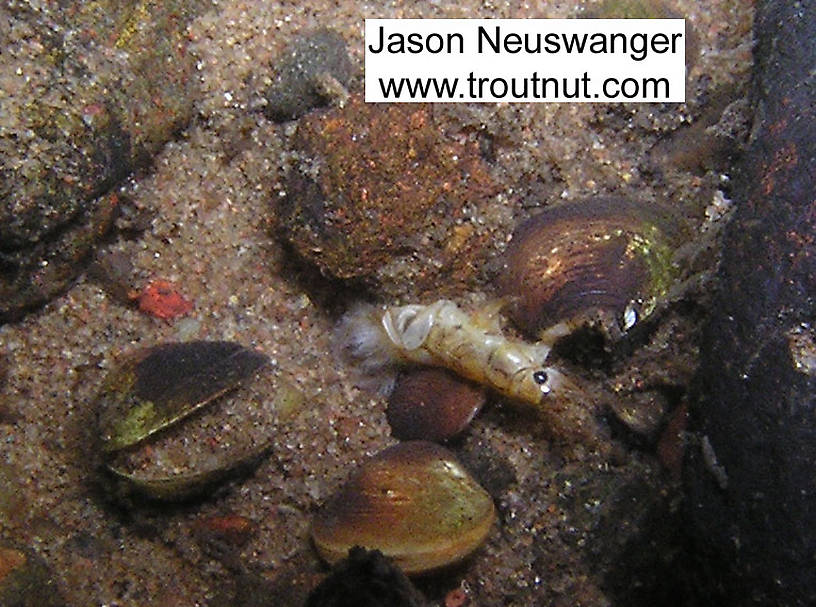
StateWisconsin
LocationNamekagon River
Date TakenApr 16, 2004
Date AddedJan 25, 2006
AuthorTroutnut
CameraOlympus C740UZ
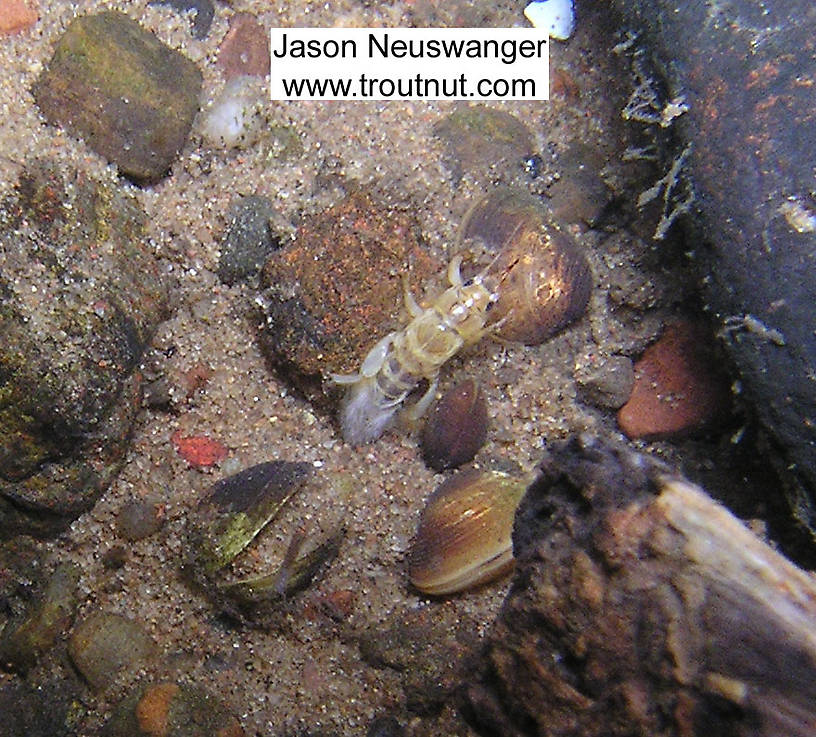
I lifted a rock in pursuit of a stonefly nymph that had scurried beneath it, and instead I found this Ephemera simulans burrowing mayfly nymph waiting to be photographed.
In this picture: Mayfly Species Ephemera simulans (Brown Drake).
In this picture: Mayfly Species Ephemera simulans (Brown Drake).
StateWisconsin
LocationNamekagon River
Date TakenApr 16, 2004
Date AddedJan 25, 2006
AuthorTroutnut
CameraOlympus C740UZ
Ephemera 2
Starring: Ephemera simulans Mayfly Nymph
This little Ephemera nymph swam around for a while and tried to burrow into the sand in my photography tank.
Ephemera 1
Starring: Ephemera simulans Mayfly Nymph
LocationNamekagon River
Date ShotJan 13, 2004
Date AddedMar 31, 2006
AuthorTroutnut
CameraOlympus C740UZ
Recent Discussions of Ephemera simulans
Brown Drake? 20 Replies »
Came across a mayfly on the Paint River by Crystal Falls, Michigan on June 17th. Is it a brown drake?
Thanks.
ReplyBrown Drake - emergence cycle??? 5 Replies »Thanks.
Posted by AftonAngler on Jun 5, 2006
Last reply on Jun 8, 2006 by Wiflyfisher
Well the Brown Drakes are happening up in Bayfield, Douglas and Sawyer County streams now.
I was talking with the Queen of the Brown Drakes - Chloe Manz the other day and she was insisting that the nymphs only emerge in the late evening. I was countering that I was under the impression that they emerge in the early morning hours and sometimes during the mid day hours.
Any acurate info???
Observation on my part has subimagos around during the daylight and taking refuge in the riprian foliage until a return to the water in the very late evening (under the right conditions) as imagos for a mating flight and egg laying.
I would be interested to know if anyone has had any success fishing the emerging nymphs. I have ties up some nice, big soft hackles and am itching to give em a whirl.
By the way....there is a masking hatch up near my home stream of Sulphurs that takes a trump card over the bigger Brown Drake most evenings...last night I mistakenly switched to a Brown Drake spinner after very successfully fishing a Sulphur dun for an hour.
I could hear the fish change the sucking noises as the evening progressed into darkness and spent a unfruitfull 1/2 hour steadily working a couple of very nice fish with the brown drake spent pattern before turning my attention to the evidence...I put the headlamp on the surface and saw that the Sulphur spinners were much more predominant.
I then switched to a more appropriate spent pattern and got a bit of redemption!
Glorious evening none the less and lesson well learned!
ReplyI was talking with the Queen of the Brown Drakes - Chloe Manz the other day and she was insisting that the nymphs only emerge in the late evening. I was countering that I was under the impression that they emerge in the early morning hours and sometimes during the mid day hours.
Any acurate info???
Observation on my part has subimagos around during the daylight and taking refuge in the riprian foliage until a return to the water in the very late evening (under the right conditions) as imagos for a mating flight and egg laying.
I would be interested to know if anyone has had any success fishing the emerging nymphs. I have ties up some nice, big soft hackles and am itching to give em a whirl.
By the way....there is a masking hatch up near my home stream of Sulphurs that takes a trump card over the bigger Brown Drake most evenings...last night I mistakenly switched to a Brown Drake spinner after very successfully fishing a Sulphur dun for an hour.
I could hear the fish change the sucking noises as the evening progressed into darkness and spent a unfruitfull 1/2 hour steadily working a couple of very nice fish with the brown drake spent pattern before turning my attention to the evidence...I put the headlamp on the surface and saw that the Sulphur spinners were much more predominant.
I then switched to a more appropriate spent pattern and got a bit of redemption!
Glorious evening none the less and lesson well learned!
Your Thoughts On Ephemera simulans:
Top 10 Fly Hatches
Top Gift Shop Designs
Eat mayflies.
Top Insect Specimens
Miscellaneous Sites
Troutnut.com is copyright © 2004-2024 Jason
Neuswanger (email Jason). See my FAQ for information about use of my images.
 privacy policy
privacy policy
